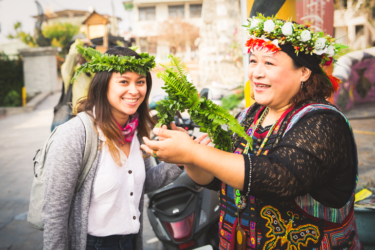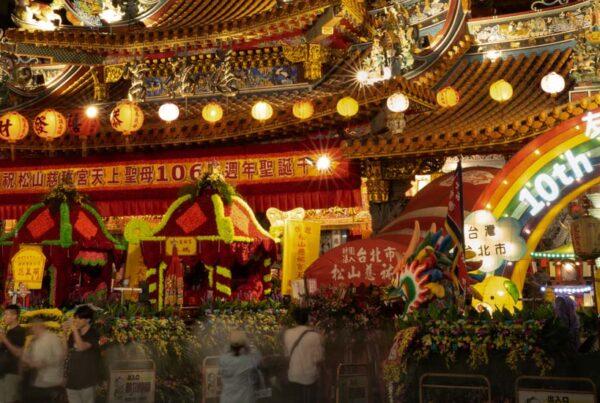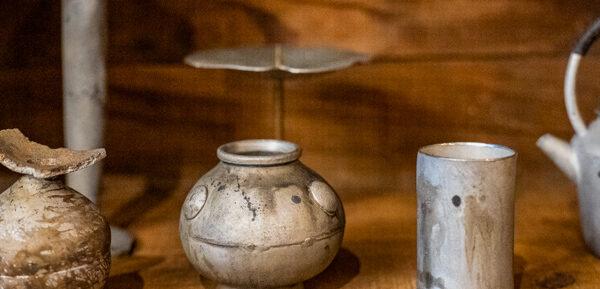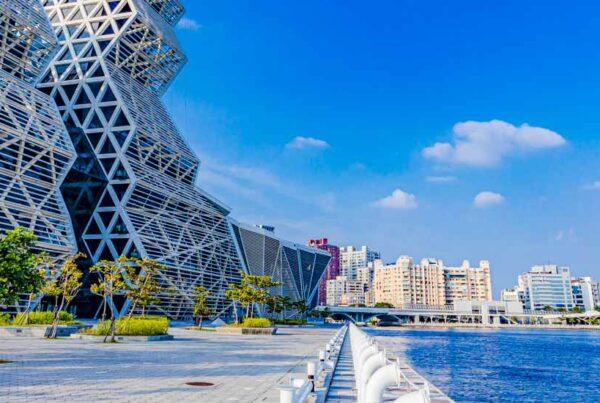Happy Times in Hakka Land
Text: Han Cheung; Photos: Maggie Song
The Hakka people are proud of their culture and heritage, which are both presented in informative and entertaining ways in museums and theme parks around Taiwan. One of the best and largest of these facilities is the Liudui Hakka Cultural Park in southern Taiwan.
Along long time ago, the ancestors of the Hakka loved exploring, and took a flying ship to search for paradise. When they arrived at Hakka Land, they found that this place had giant trees, lush bamboo forests, many rivers, and fertile floodplains. Thus, they decided to stay here and start their new migrant life.”

Visiting the Liudui Hakka Cultural Park
So reads the introduction to Hakka Land, an interactive-activity center at the Liudui Hakka Cultural Park in Pingtung County, southern Taiwan, where children assume the role of pioneers and learn about the many aspects of traditional Hakka culture, including fabric dyeing, medicine, and how the people of this Han Chinese ethnic minority cultivated their new land and protected it from invaders.
Of course, the Hakka people did not in fact arrive in Taiwan via spaceship. Historians believe that these itinerant people originated in northern China and, over a period of many centuries, spread far and wide, with a significant population eventually settling on this island.
Liudui, literally “six mounds,” is an old name for an expansive area in southern Taiwan. The name originated during an uprising led by a Hoklo immigrant, Zhu Yi-gui, against the Qing authorities in 1721. “Hoklo” refers to the Han Chinese majority-group immigrants who primarily came from mainland China’s Fujian Province. To protect their home turf against the marauding rebels, the Hakka living in rural areas of today’s Kaohsiung City and Pingtung County formed six local militias, or “dui” (隊) in Chinese. These successfully completed their task, and with peace restored after the short-lived uprising had ended the locals changed the original “dui” to a same-sounding character (堆) meaning “mound.”

Model of typical traditional farmhouse in the Liudui area
The Liudui Hakka Cultural Park is one of two large-scale Hakka-themed cultural parks run by the Hakka Affairs Council. The other is located in Miaoli County in northwestern Taiwan. In contrast to the smaller Miaoli park, at Liudui significant resources have been allocated to create natural ecosystems and landscape forms such as wetlands and grasslands that feature typical plants cultivated by the Hakka. The park also has farmland areas where visitors can participate in the planting and harvesting of important crops and engage in such activities as the making of scarecrows.
The core area of the park, containing most of the exhibits, performance spaces, activity centers, and restaurants, is easily navigable by foot. Bike rentals are available for those who want to explore a bit more of the park’s grounds and enjoy some quietude away from the crowds.
Inside the main area, in one section visitors can walk under six massive steel-frame structures that resemble Hakka-style oil-paper umbrellas, with sprawling foliage forming intricate webs beneath the structures. Legend has it that Pingtung County was once home to a thick forest that blocked the sky from view, and that one could walk for days without seeing the sunlight – one of the inspirations for this section’s design. Some also say that the structures look like the traditional conical hats that farmers in Taiwan wear while tending fields.

Massive steel-frame structures in the shape of oil-paper umbrellas
Children can have fun playing with water when the fountains hidden in the floor under one of the steel-framed umbrellas are turned on at set times of the day. And in the same manner as Hakka people followed waterways in their migrations, canals can be found throughout the park (irrigation canals are a prominent feature in the region’s agriculture). One of these ends at a large sand mound, another popular place to play with visiting kids.
The park has a well-designed exhibition on Hakka culture from which you can learn about everything from marriage customs to architecture to music to food. Much thought is put into designs heavily featuring Hakka-specific motifs and special attractions. At the time of the Travel in Taiwan visit for this article, a picnic event was being promoted – one of many special family-fun activities held throughout the year.
During your visit, apart from walking under giant oil-paper umbrellas made of steel, you can also make and paint a real oil-paper umbrella for yourself. The construction process is surprisingly simple and fun, and your finished umbrella can be used for shade and as a prop when taking photos. In Hakka culture, oil-paper umbrellas provide more than just respite from sunlight. Brides, for example, traditionally walk under a red umbrella during marriage ceremonies in order to ward off evil spirits. And since the word for “paper” and “child” sound similar in Hakka, the umbrellas are also a symbol of fertility. They are used as well in coming-of-age and religious ceremonies.




The highlight for children at the Liudui Hakka Cultural Park is definitely Hakka Land, an interactive fun area which is in fact fascinating and educational for curious, fun-loving adults as well. The displays are heavily focused on kinetic interactive technology: children can grind leicha (Hakka-style ground tea), cultivate the land, fight enemies, and create their own umbrella designs. Non-digital offerings include manning a traditional Chinese-medicine shop, letterpress printing, bamboo weaving, and running a Hakka food stall.




Elsewhere in the main park area are shops selling Hakka items, a food court with a large variety of Hakka food offerings, and a crafts workshop for visitor DIY fun. Definitely sample some of the unique foods here, including the braised pork knuckles, a special kind of sausage with fish roe, and pork belly with pickled mustard greens.

Hakka food

Funny looking scare crows

Rice paddies and farm houses
From the main area, visitors can venture out to the surrounding fields to learn more about Hakka agriculture. These include rice paddies and fields with other crops.
Tobacco-growing was once a significant Hakka industry, and visitors can check out the tobacco-drying house, which was built in 1961 and transported to the park in 2009 after donation by the owner. The smell of tobacco permeates the air, with real leaf hung up to dry. Displays tell the story of the Hakka “tobacco empire” that once was.

Tobacco-drying house

Drying tobacco leaves

Rice husking machine
There is also a rice-husking showroom, which contains a husking machine from a 100-year-old mill that was donated to the park. It’s a rare opportunity to see such an enormous machine – several floors tall – in its entirety, as usually it would be surrounded by other equipment and paraphernalia.
On the park’s grounds you’ll also spot a unique Earth God temple that resembles a local gravesite – characteristic of the Liudui Hakka specifically. It’s not exactly clear where the practice of building this type of temple originated. According to park staff, the Hakka originally imagined their deities in abstract forms, and the worship of figures was a later practice that they picked up from their Hoklo neighbors. In the old days, temples were built at the entranceways to Hakka villages, and made to look like gravesites. This was meant to trick would-be invaders into thinking that beyond this point was a cemetery, not houses.
Although the park is meant to be a place to learn about Hakka culture, it’s also a great place for a leisurely afternoon walkabout. One can walk for hours through the specially created habitats and rest on benches by the many tiny lakes, all the while imagining the fertile environment that made this area so attractive to the Hakka when they first settled here.

Fun at the Liudui Hakka Cultural Park
Add: No. 588, Xinyi Rd., Jianxing Village, Neipu Township, Pingtung County
(屏東縣內埔鄉建興村信義路588號)
Tel: (02) 723-0100
Website: thcdc.hakka.gov.tw/wSite/mp?mp=7
Tribal Villages in PINGTUNG County
taiwaneverything.cc/2018/05/28/pingtung-tribal-villages/
Bucolic Countryside: WANLUAN in Pingtung County
About the author

Han Cheung
Han Cheung moved back to his adolescent stomping grounds of Taiwan in 2015 from frigid Wyoming, where he was the editor of the small town Rawlins Daily Times. He has a Master’s in Journalism from the University of Missouri and has reporting experience in the US, Latin America, and Taiwan.

















